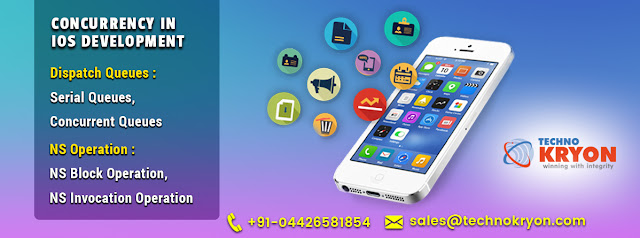Concurrency in iOS Development
 |
| Techno Kryon |
Concurrency
means the collection of techniques and mechanisms that enable a system to
perform several different tasks simultaneously. Concurrency is considered hard
to understand. It helps to write powerful, fast execution, and reactive apps.
In iOS we
have NSOperation and Dispatch Queues to perform concurrency.
·
Utilize
device hardware: Now all devices have a multi-core processor that
allows developers to execute multiple processes in parallel. We should utilize
this feature and get benefits out of the hardware.
·
Better user experience: While performing heavy
tasks UI will freeze till the task execution. When the user faces this
situation, the first step that user will take to uninstall/close your app
without a second thought. With concurrency, all these tasks can be done in the
background without changing the main thread or disturbing your users. They can
still tap on buttons, scroll and navigate through your app, while it handles
the heavy loading task in the background.
·
The APIs like NSOperation and dispatch queues
make it easy to use concurrency: Creating and managing threads are not easy
tasks. Another important advantage about these APIs is that it helps you
achieve synchronization easily to avoid a race condition. Race condition
happens when multiple threads try to access the shared resource and that leads
to unexpected results. By usage of synchronization, resources are protected
from being shared between multiple threads.
GCD (Grand Central Dispatch)
GCD is
the most frequently used API to manage concurrency and execute operations
asynchronously at the kernel unix level of the system. GCD provides and manages
queues of processes.
Dispatch Queues:
It is an
easy way to perform tasks asynchronously and parallelly in your application.
Tasks are submitted in form of blocks. There are two types of dispatch queues:
(1) serial queues (2) concurrent queues. All process will run in separate
threads instead of the main thread.
Serial Queues:
This
queue can only execute one task at a time. All processes in the same queue will
execute linearly. Tasks can be executed concurrently by using multiple serial
queues.
The advantages of using serial queues:
·
Guaranteed serialized access to a shared resource
that avoids deadlock.
·
Tasks are executed in a linear predicted order.
When you submit tasks in a serial dispatch queue, they will be executed in FIFO
(First In First Out) order.
·
You can create several numbers of serial queues.
Concurrent Queues:
It allows
you to execute multiple processes in parallel. Their execution all occur
concurrently and don’t have to wait for other processes to start. Concurrent
queues begin in the same order but the order of execution cannot be determined,
throughput time or the number of the process being executed at a given point.
·
DISPATCH_QUEUE_PRIORITY_HIGH
·
DISPATCH_QUEUE_PRIORITY_DEFAULT
·
DISPATCH_QUEUE_PRIORITY_LOW
·
DISPATCH_QUEUE_PRIORITY_BACKGROUND
These queue types represent the priority of
execution.
NSOperation
In iOS SDK, there
are two subclasses of NSOperation. The two classes are:
1.
NSBlockOperation:
This class is used to initiate the operation with one or more
blocks. It can contain more than a block and will be considered as finished
when all blocks are executed.
2.
NSInvocationOperation: Use this
class to start a process that consists of invoking a selector on a specified
object.
Advantages of NSOperation:
1.
It supports dependencies through the method
addDependency in the NSOperation class. When needed to start a process that
depends on the execution of the other NSOperation is used.
2.
Secondly, you can change the execution priority
by setting the property queue priority.
3.
Tasks with higher priority will be executed first.
4.
You can cancel a particular block or all blocks
for any given queue. The task can be cancelled after added to the queue.
5.
It has three helpful boolean properties which are
finished, cancelled, and ready. Finished will be set to true once process
execution is done. Cancelled is set to true once the process has been
cancelled. Ready is set to true once the process is about to be executed now.
6.
It has an option to set completion block to be
called once the task is finished. The completion block will be called once the
boolean property (finished) is set to true in NSOperation.



Comments
Post a Comment